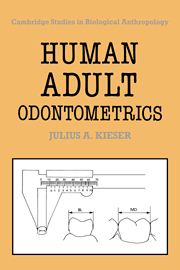Book contents
- Frontmatter
- Contents
- Foreword
- Preface
- 1 Introduction
- 2 Measurement of tooth size
- 3 Inheritance of tooth size
- 4 Comparative odontometry
- 5 Odontometric trends
- 6 Sexual dimorphism in tooth size
- 7 Odontometric variability
- 8 Compensatory tooth size interactions
- 9 Fluctuating odontometric asymmetry
- 10 Allometric relations of tooth size
- Odontometric appendix
- References
- Index
7 - Odontometric variability
Published online by Cambridge University Press: 05 February 2012
- Frontmatter
- Contents
- Foreword
- Preface
- 1 Introduction
- 2 Measurement of tooth size
- 3 Inheritance of tooth size
- 4 Comparative odontometry
- 5 Odontometric trends
- 6 Sexual dimorphism in tooth size
- 7 Odontometric variability
- 8 Compensatory tooth size interactions
- 9 Fluctuating odontometric asymmetry
- 10 Allometric relations of tooth size
- Odontometric appendix
- References
- Index
Summary
Introduction
In seeking to understand the metrical variability of human teeth, two directions of inquiry seem most plausible. One may start with the tooth as an end-product of odontogenesis and look back, beginning with the embryological evidence, morphodifferentiation and biochemical generalisations, in moving toward an understanding of the genetic basis of tooth formation. Alternatively, one may start with the observed variability and look forward and attempt to formulate mathematical relationships between the variabilities of different teeth. In a completely successful formulation, these two approaches should converge.
The present chapter deals with some aspects of the metrical variation of human teeth. It looks back to the various theories of odontogenesis and looks forward to the patterning of variability. Its failure to synthesise these two approaches should be seen as a call for more concentrated research in this field.
Butler's field theory
Huxley & de Beer (1934) have emphasised perceptively the existence of gradation of morphogenetic substances within the developing embryo. For instance, in Amblystoma, the forelimb develops from a discoid zone or field on the side of the body. It is important to note that these authors could not identify a definite area within the field from which the limb always generated. Hence they concluded that inherent in all the regions within the field, was the power of limb formation. They were, however, able to show that limb forming potency was highest in a subcentral region within the field, from which the effect tapered off towards the periphery. Their inevitable conclusion was that morphogenetic substances aggregated in definite presumptive areas within the embryo, from which different organ systems were generated.
- Type
- Chapter
- Information
- Human Adult OdontometricsThe Study of Variation in Adult Tooth Size, pp. 74 - 88Publisher: Cambridge University PressPrint publication year: 1990
- 1
- Cited by



